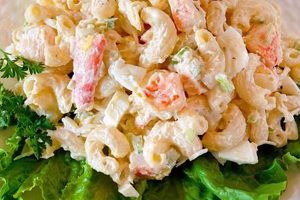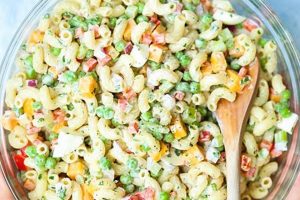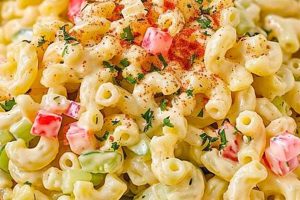A chilled pasta dish featuring cooked elbow macaroni, combined with a creamy dressing often based on mayonnaise. Typical additions include various cheeses such as cheddar, Colby, or Swiss, along with chopped vegetables like celery, onion, and bell peppers. Hard-boiled eggs, pickles, and mustard can also enhance the flavor profile. Specific formulations vary widely, offering a range of flavor combinations from tangy and savory to sweet and creamy.
This dish is a popular choice for potlucks, picnics, and barbecues due to its ease of preparation, transportability, and adaptability to diverse palates. Its versatility allows for customization with different cheese varieties, vegetables, and seasonings. The dish offers a balance of carbohydrates from the pasta, protein from the eggs and cheese, and fiber from the vegetables. Its creamy texture and rich flavor contribute to its widespread appeal. Historically, pasta salads gained popularity in the mid-20th century as refrigeration became more common, enabling safe storage of mayonnaise-based dishes.
The following sections will explore ingredient selection, preparation techniques, variations, and storage recommendations for creating a successful and satisfying version of this classic dish.
Tips for a Superior Macaroni Salad
Achieving optimal results requires attention to detail throughout the preparation process. The following tips offer guidance for creating a flavorful and well-balanced dish.
Tip 1: Pasta Perfection: Cook pasta al dente for optimal texture. Overcooked pasta can result in a mushy salad. Rinse cooked pasta under cold water to stop the cooking process and maintain firmness.
Tip 2: Cheese Selection: Sharp cheddar, Colby, or Swiss cheeses provide classic flavor profiles. Experimenting with crumbled blue cheese or shredded Monterey Jack can add unique dimensions.
Tip 3: Vegetable Enhancement: Finely diced celery, red onion, and bell peppers contribute both flavor and visual appeal. Consider blanching vegetables briefly to retain crispness and vibrant color.
Tip 4: Dressing Dynamics: High-quality mayonnaise forms the base of a creamy dressing. Enhance the flavor with Dijon mustard, apple cider vinegar, or a touch of sweet pickle relish.
Tip 5: Seasoning Subtleties: Freshly ground black pepper, paprika, and garlic powder complement the other flavors. Salt should be added judiciously, tasting and adjusting as needed.
Tip 6: Chill Out: Allow the salad to chill thoroughly in the refrigerator for at least two hours before serving. This allows the flavors to meld and the salad to reach the ideal serving temperature.
Tip 7: Garnish Gracefully: A sprinkle of chopped fresh parsley or paprika adds a final touch of color and flavor. Consider garnishing with reserved cheese or chopped hard-boiled egg.
By following these tips, one can create a macaroni salad that is both delicious and visually appealing. Careful attention to ingredient selection, preparation techniques, and chilling time ensures a successful and satisfying culinary experience.
This exploration of tips provides a strong foundation for crafting exceptional macaroni salad. The following section will offer concluding remarks and suggest further avenues for culinary exploration.
1. Elbow Macaroni
Elbow macaroni’s unique shape and characteristics make it the cornerstone of classic macaroni salad. Its curved tube form and ridged exterior contribute significantly to the dish’s overall texture and flavor absorption, distinguishing it from other pasta shapes in this specific culinary context.
- Shape and Texture
The curved, hollow shape of elbow macaroni allows it to hold onto the creamy dressing effectively, ensuring each bite is flavorful. This shape also contributes to a pleasant mouthfeel, distinct from straight or spiral pasta. The ridges on the pasta’s exterior provide additional surface area for the dressing to cling to, maximizing flavor delivery.
- Size and Proportion
Elbow macaroni’s relatively small size makes it ideal for mixing with other ingredients in a salad, ensuring a balanced distribution of flavors and textures. Its size also allows for easy handling with a fork or spoon. This bite-sized nature contributes to the ease and enjoyment of consuming the salad.
- Cooking Properties
Elbow macaroni cooks relatively quickly and evenly, simplifying the preparation process. Its ability to maintain a firm texture when cooked al dente is crucial for preventing a mushy salad. This characteristic ensures the pasta remains a distinct textural element within the dish.
- Flavor Absorption
While elbow macaroni itself has a neutral flavor, its porous nature allows it to readily absorb the flavors of the dressing and other ingredients. This absorption contributes to a harmonious blend of flavors throughout the salad, rather than isolated pockets of seasoning.
These combined characteristics contribute to elbow macaroni’s suitability for macaroni salad, creating a dish with a balanced blend of flavors, textures, and ease of consumption. Substituting other pasta shapes can significantly alter the final product’s character, highlighting the integral role of elbow macaroni in this classic dish.
2. Cheese Selection
Cheese selection significantly influences the overall flavor profile of macaroni salad. Different cheeses contribute unique textures and tastes, impacting the final dish’s character. Understanding these nuances allows for informed decisions aligned with desired outcomes, whether emphasizing sharpness, creaminess, or a balanced flavor profile. The choice of cheese acts as a defining element, shaping the culinary experience.
Sharp cheddar, a popular choice, imparts a tangy, robust flavor that complements the creamy dressing. Its firm texture holds up well in the salad, maintaining a distinct presence. Mild cheddar offers a softer, less intense flavor for those who prefer a milder taste. Colby, known for its smooth, creamy texture, adds a subtle nuttiness. Swiss cheese, with its characteristic holes and mild, nutty flavor, introduces both visual and gustatory interest. crumbled blue cheese, while more pungent, provides a complex, salty flavor that complements bolder dressings. Each cheese interacts differently with the other ingredients, highlighting the importance of careful selection.
Consider the overall flavor balance when choosing cheese. A sharp cheddar might overpower a delicate dressing, while a mild cheese might get lost against bolder flavors. The interplay between cheese, dressing, and other ingredients is crucial. The quantity of cheese used also impacts the final result. Too much cheese can make the salad dense and heavy, while too little might not provide sufficient flavor. Experimentation with different cheese combinations can lead to unique and satisfying flavor profiles. Balancing flavors and textures through judicious cheese selection elevates macaroni salad from simple to exceptional.
3. Dressing Consistency
Dressing consistency plays a crucial role in the overall success of macaroni salad with cheese. The balance between creaminess, viscosity, and flavor distribution directly impacts the final product’s palatability and textural appeal. An overly thick dressing can result in a heavy, gloppy salad, while a thin, watery dressing fails to coat the pasta and other ingredients adequately. The desired consistency allows the dressing to cling evenly to the macaroni, distributing flavor throughout while maintaining the salad’s structural integrity. This balance ensures a pleasant eating experience.
Mayonnaise typically serves as the base for macaroni salad dressing, providing the characteristic creaminess. The amount of mayonnaise used directly influences the dressing’s thickness. Other ingredients, such as vinegar, mustard, and sour cream, contribute to both flavor and consistency. Vinegar or lemon juice adds tanginess and thins the dressing, while mustard contributes a sharp flavor and can slightly thicken it. Sour cream or yogurt can create a lighter, tangier dressing with a thinner consistency. Achieving the right balance requires careful consideration of these ingredients’ interplay and their impact on the final product. For example, a dressing heavy on mayonnaise with minimal vinegar will be thicker and richer, whereas one with more vinegar and less mayonnaise will be thinner and tangier. The specific recipe and desired outcome dictate the optimal proportions of these components.
Understanding the factors influencing dressing consistency allows for informed adjustments and customization. If a dressing is too thick, adding small amounts of vinegar or milk can thin it out. Conversely, if a dressing is too thin, whisking in additional mayonnaise or a small amount of sour cream can thicken it. Regularly tasting and adjusting throughout the preparation process ensures the desired consistency and flavor balance. Achieving the optimal dressing consistency contributes significantly to a successful macaroni salad with cheese, ensuring a harmonious blend of flavors, textures, and a pleasant eating experience. This attention to detail elevates the dish beyond a simple side to a carefully crafted culinary creation.
4. Vegetable Additions
Vegetable additions contribute significantly to the texture, flavor, and nutritional value of macaroni salad with cheese. Beyond mere embellishment, they introduce complexity and balance, transforming a simple pasta dish into a more substantial and satisfying culinary experience. The thoughtful incorporation of vegetables elevates the salad from basic to nuanced, offering a wider range of flavors and textures. Strategic selection and preparation of vegetables are essential for optimizing their contribution to the overall composition of the salad.
- Textural Contrast
Vegetables introduce crucial textural contrast to macaroni salad. The creamy pasta and cheese benefit from the crispness of vegetables like celery, bell peppers, and red onion. This interplay of textures creates a more dynamic and engaging eating experience. Blanching or quick-pickling vegetables can further enhance their textural contribution, preserving their crispness while adding subtle flavor nuances. The contrast between soft and crunchy elements prevents the salad from becoming monotonous.
- Flavor Complexity
Beyond textural contrast, vegetables contribute layers of flavor. The peppery bite of red onion, the sweetness of bell peppers, and the subtle bitterness of celery all interact with the richness of the cheese and the creaminess of the dressing. This complexity elevates the salad beyond a simple combination of ingredients. Incorporating herbs like dill or parsley can further enhance the flavor profile, adding freshness and aromatic complexity.
- Nutritional Enhancement
Vegetables enrich macaroni salad with essential vitamins, minerals, and fiber, transforming it into a more nutritious meal option. The addition of colorful vegetables like carrots, bell peppers, and red onion not only enhances visual appeal but also contributes antioxidants and other beneficial nutrients. This nutritional boost elevates the salad from a simple indulgence to a more wholesome dish.
- Visual Appeal
Brightly colored vegetables significantly enhance the visual appeal of macaroni salad with cheese. The vibrant hues of red onion, green bell peppers, orange carrots, and flecks of green herbs create a more visually appealing and appetizing dish. This visual enhancement makes the salad more inviting and contributes to a more satisfying dining experience.
The strategic inclusion of vegetables in macaroni salad with cheese demonstrably elevates the dish. By considering texture, flavor, nutrition, and visual appeal, the careful selection and preparation of vegetables transforms a basic pasta salad into a more complex and satisfying culinary creation. This attention to detail elevates the dish from simple sustenance to a well-rounded and enjoyable meal component.
5. Seasoning Balance
Seasoning balance is paramount in a successful macaroni salad with cheese recipe. It elevates the dish beyond a simple combination of ingredients, creating a harmonious flavor profile where each component complements the others. Without proper seasoning, the inherent flavors of the pasta, cheese, and vegetables remain muted, resulting in a bland and uninspired final product. Conversely, over-seasoning can overwhelm the palate, obscuring the individual flavors and creating an unbalanced, disharmonious taste. The objective is to enhance, not mask, the inherent flavors of the ingredients. This requires careful consideration of the interplay between salt, pepper, and other spices.
Salt, a fundamental seasoning, enhances the flavors of the other ingredients. However, its use requires restraint. Too much salt can create an unpleasantly salty dish, while too little leaves the salad tasting flat. Freshly ground black pepper adds a subtle heat and complexity. Its pungency contrasts with the creamy dressing and rich cheese, creating a more dynamic flavor profile. Other spices, such as garlic powder, onion powder, or paprika, can further enhance the flavor profile, but their use should be judicious. Overpowering spices can mask the delicate flavors of the other ingredients. For example, a heavy hand with garlic powder can overwhelm the subtle nuttiness of Swiss cheese. The goal is to create a balanced flavor profile where each seasoning complements the others without dominating the overall taste.
Achieving seasoning balance requires continuous tasting and adjustment throughout the preparation process. Initial seasoning provides a foundation, but flavors can change as the salad chills and ingredients meld. Tasting the salad after chilling allows for final adjustments, ensuring the optimal balance before serving. This iterative process is crucial for achieving a well-seasoned and flavorful macaroni salad with cheese. Ultimately, a well-balanced seasoning profile elevates the dish from simple to sophisticated, transforming a collection of ingredients into a cohesive and satisfying culinary experience.
6. Chilling Time
Chilling time is an integral component of a successful macaroni salad with cheese recipe, significantly impacting both flavor development and food safety. This period of refrigeration allows the flavors of the various componentspasta, cheese, vegetables, and dressingto meld and harmonize, resulting in a more cohesive and balanced flavor profile. The chilling process also firms the pasta, enhancing the salad’s textural appeal. From a food safety perspective, adequate chilling time inhibits bacterial growth, particularly crucial in mayonnaise-based dressings, ensuring the dish remains safe for consumption.
The effect of chilling time on flavor development is analogous to marinating. As the salad chills, the dressing’s flavors permeate the pasta and vegetables, while the individual components’ flavors meld together. A freshly made macaroni salad, while palatable, often lacks the depth and complexity of flavor achieved after a period of chilling. For example, the sharpness of cheddar cheese becomes more integrated with the creamy dressing, and the pungency of onions mellows, creating a more harmonious flavor profile. Furthermore, chilling allows the pasta to absorb the dressing more fully, enhancing its flavor and preventing a watery or diluted final product. This absorption also improves the salad’s overall texture, preventing the pasta from becoming mushy or overly soft.
Chilling macaroni salad for a sufficient durationideally two hours or moreis crucial for maximizing flavor development and ensuring food safety. This chilling period allows for optimal flavor melding and bacterial growth inhibition. Insufficient chilling time can result in a bland, less flavorful salad and may pose a risk of foodborne illness. Therefore, incorporating adequate chilling time is not merely a recommendation but a crucial step in preparing a safe and flavorful macaroni salad with cheese. This understanding highlights the importance of time and temperature control in culinary practices, underscoring their significant impact on both the sensory experience and the safety of the final product.
Frequently Asked Questions
This section addresses common inquiries regarding macaroni salad with cheese preparation, offering concise and informative responses to clarify potential uncertainties and enhance culinary understanding.
Question 1: What type of pasta is best suited for macaroni salad?
Elbow macaroni is the traditional and recommended choice due to its shape, which holds dressing well. Other small pasta shapes may be substituted, but the final texture may vary.
Question 2: Can different cheeses be used?
Variations in cheese selection offer diverse flavor profiles. Cheddar, Colby, Swiss, and Monterey Jack are common choices, but experimentation is encouraged. Consider the cheese’s sharpness and texture when making substitutions.
Question 3: How can one prevent the salad from becoming watery?
Thoroughly draining the cooked pasta and ensuring the vegetables are dry before incorporating them into the salad helps prevent excess moisture. Properly chilling the salad also allows the pasta to absorb the dressing, reducing wateriness.
Question 4: How long can macaroni salad with cheese be stored safely?
Refrigeration at or below 40F (4C) is crucial. Macaroni salad with cheese is typically safe to consume for three to five days when stored properly in an airtight container. Discard any salad that shows signs of spoilage, such as an off odor or discoloration.
Question 5: Can macaroni salad with cheese be frozen?
Freezing is not recommended. Mayonnaise-based dressings often separate and become watery upon thawing, negatively impacting the salad’s texture and overall quality. The texture of the vegetables can also be compromised by freezing.
Question 6: How can the flavor of macaroni salad with cheese be enhanced?
Fresh herbs, such as dill, parsley, or chives, can add brightness and complexity. Spices like paprika, garlic powder, or onion powder offer additional flavor dimensions. Incorporating different types of vinegar, such as apple cider or red wine vinegar, can also enhance the flavor profile.
Addressing these common inquiries provides a comprehensive understanding of macaroni salad with cheese preparation. Careful attention to ingredient selection, preparation methods, and storage guidelines ensures a safe and flavorful culinary experience.
This FAQ section provides valuable insights into achieving optimal results when preparing macaroni salad with cheese. The following section will offer a concluding summary and potential avenues for further culinary exploration.
Macaroni Salad with Cheese Recipe
This exploration of macaroni salad with cheese recipes has provided a comprehensive overview of this classic dish. Key elements, including pasta selection, cheese varieties, dressing consistency, vegetable additions, seasoning balance, and chilling time, contribute significantly to the final product’s quality. Understanding the interplay of these components allows for informed decision-making during preparation, enabling culinary enthusiasts to create flavorful and texturally appealing macaroni salads. Emphasis on ingredient quality and adherence to established food safety guidelines ensures a safe and satisfying dining experience.
Macaroni salad with cheese, though seemingly simple, offers a canvas for culinary creativity. Exploration of diverse ingredient combinations and flavor profiles allows for personalized interpretations of this versatile dish. Continued experimentation and refinement of techniques promise rewarding culinary experiences, transforming a familiar staple into a personalized expression of culinary artistry. The potential for innovation within this seemingly simple dish remains vast, inviting further exploration and refinement.






